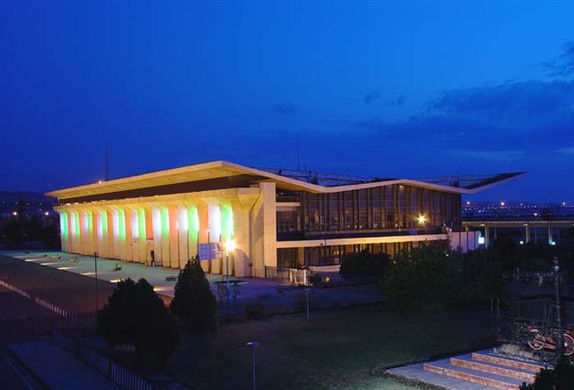This is an old revision of this page, as edited by Samak (talk | contribs) at 11:53, 24 March 2016 (→Culture). The present address (URL) is a permanent link to this revision, which may differ significantly from the current revision.
Revision as of 11:53, 24 March 2016 by Samak (talk | contribs) (→Culture)(diff) ← Previous revision | Latest revision (diff) | Newer revision → (diff)
| Part of a series on |
| Azerbaijanis |
|---|
| Culture |
| Traditional areas of settlement |
| Diaspora |
| Religion |
| Language |
| Persecution |
37°36′N 47°00′E / 37.6°N 47.0°E / 37.6; 47.0 Azerbaijan or Azarbaijan (Template:Lang-fa Āzarbāijān; Template:Lang-az-Arab Azərbaycan), also Iranian Azerbaijan, is a region in northwestern Iran that borders Iraq, Turkey, the Nakhchivan Autonomous Republic, Armenia, and the Republic of Azerbaijan. Iranian Azerbaijan is administratively divided into West Azerbaijan Province, East Azerbaijan Province, Ardabil Province, and Zanjan Province. The region is mostly populated by Azerbaijanis, with minority populations of Kurds, Armenians, Persians, Talysh, and Assyrians.
Iranian Azerbaijan is the land originally and historically called Azerbaijan; the Azerbaijani-populated Republic of Azerbaijan appropriated the name of the neighboring Azerbaijani-populated region in Iran during the 20th century. Historic Azerbaijan was called Atropatene in antiquity and Aturpatakan in the pre-Islamic Middle Ages. Some refer to Iranian Azerbaijan as South (or Southern) Azerbaijan and the Republic of Azerbaijan as Northern Azerbaijan, although others believe that these terms are irredentist and politically motivated.
Prior to the Russo-Persian wars of the 19th century, the Azerbaijani people were distributed throughout the northwestern Persian Empire, with the highest concentrations in Persian provinces that correspond to contemporary Iranian Azerbaijan and the Republic of Azerbaijan. Following military defeats at the hands of the Russian Empire, Qajar Persia ceded all of its territories in the North Caucasus and Transcaucasia to Russia via the Treaty of Gulistan of 1813 and the Treaty of Turkmenchay of 1828. Since then the Azerbaijani people have been partitioned between nations. The territories south of the Aras River, which comprised the region historically known as Azerbaijan, became the new northwest frontier of the Persian Empire and later Iran. The territories north of the Aras River, which were not known by the name Azerbaijan at the time of their capture by Russia, were absorbed into the Russian Empire, renamed the Azerbaijan Democratic Republic during the country's short-lived independence from 1918 to 1920, incorporated into the Soviet Union as the Azerbaijan Soviet Socialist Republic, and finally became the independent Republic of Azerbaijan when the Soviet Union dissolved.
Etymology and usage
The name Azerbaijan itself is derived from Atropates, the Persian Satrap (governor) of Medea in the Achaemenid empire, who ruled a region found in modern Iranian Azerbaijan called Atropatene. Atropates name is believed to be derived from the Old Persian roots meaning "protected by fire." The name is also mentioned in the Avestan Frawardin Yasht: âterepâtahe ashaonô fravashîm ýazamaide which translates literally to: "We worship the Fravashi of the holy Atare-pata." According to the Encyclopedia of Islam: "In Middle Persian the name of the province was called Āturpātākān, older new-Persian Ādharbādhagān آذربادگان/آذرآبادگان, Ādharbāyagān, at present Āzerbāydjān/Āzarbāydjān, Greek ᾿Ατροπατήνη, Byzantine Greek ᾿Αδραβιγάνων, Armenian Atrpatakan, Syriac Adhorbāyghān." The name Atropat in Middle Persian was transformed to Adharbad and is connected with Zoroastrianism. A famous Zoroastrian priest by the name Adarbad Mahraspandan is well known for his counsels. Azerbaijan, due to its numerous fire-temples has also been quoted in a variety of historic sources as being the birthplace of the prophet Zoroaster although modern scholars have not yet reached an agreement on the location of his birth.
Upon Qajar Iran's forced ceding of its Caucasian territories north of the Aras River, comprising modern-day Georgia, Dagestan, Armenia, and the Republic of Azerbaijan in the course of the 19th century to Imperial Russia, through the treaties of Gulistan (1813) and Turkmenchay (1828), the latter was eventually named Azerbaijan as well, following disintegration of the Russian Empire and the establishment of the Azerbaijan Democratic Republic in 1918 by the Musavat party.
History
Main articles: History of Iran and History of Azerbaijan


Pre-Islamic period
The oldest kingdom known in Iranian Azerbaijan is that of the Mannea who ruled a region southeast of Lake Urmia centered around modern Saqqez. The Manneans were a confederation of Iranian and non-Iranian groups. According to Professor Zadok:
it is unlikely that there was any ethnolinguistic unity in Mannea. Like other peoples of the Iranian plateau, the Manneans were subjected to an ever increasing Iranian (i.e., Indo-European) penetration.
The Mannaeans were conquered and absorbed by an Iranian people called Matieni, and the country was called Matiene, with Lake Urmia called Lake Matianus. Matiene was later conquered by the Medes and became a satrapy of the Median empire and then a sub-satrapy of the Median satrapy of the Persian Empire.
According to Encyclopædia Britannica, the Medes were an:
Indo-European people, related to the Persians, who entered northeastern Iran probably as early as the 17th century BC and settled in the plateau land that came to be known as Media.
After Alexander the Great conquered Persia, he appointed (328 BC) as governor the Persian general Atropates, who eventually established an independent dynasty. The region, which came to be known as Atropatene or Media Atropatene (after Atropates), was much disputed. In the 2nd century BC, it was liberated from Seleucid domination by Mithradates I of Arsacid dynasty, and was later made a province of the Sassanid Empire of Ardashir I. Under the Sassanids, Azerbaijan was ruled by a marzubān, and, towards the end of the period, belonged to the family of Farrokh Hormizd.
Large parts of the region were conquered by the Kingdom of Armenia. Large parts of the region made up part of historical Armenia. The parts of historical Armenia within what is modern-day Azerbaijan comprise; Nor Shirakan, Vaspurakan, and Paytakaran. Vaspurakan, of which large parts were located in what is modern-day Iranian Azerbaijan is described as the cradle of Armenian civilization.
On 26 May 451 AD, a very important battle was fought that would prove immensely pivotal in Armenian history. On the Avarayr Plain, at what is modern-day Churs (modern-day West Azerbaijan Province), the Armenian Army under Vardan Mamikonian clashed with Sassanid Persia. Although the Persians were victorious on the battlefield itself, the battle proved to be a major strategic victory for Armenians, as Avarayr paved the way to the Nvarsak Treaty (484 AD), which affirmed Armenia's right to practice Christianity freely.
Heraclius, the Byzantine emperor, briefly held the region in the 7th century until peace was made with the Sassanids. After the Islamic Conquest of Iran, Arab invaders converted most of its people to Islam and made it part of the caliphate.
Islamic period
Sasanian and early Islamic period
During the Arab invasion of Iran, the name of the Spahbed of Iran was Rostam Farrokhzad, the son of Farrukh Hormizd, who was the son of Vinduyih, the uncle of Khosrau I and brother of the Sasanian usurper Vistahm. Rustam himself was born in Azerbaijan and led the Sasanian army into battle. He is also mentioned in the Shahnameh.
The Sasanian army was defeated at the battle of al-Qādisiyyah and Rostam Farrokhzad, along with many other Sasanian veterans was killed. In 642, Piruz Khosrow, one of the Sasanian survivors during the battle of al-Qādisiyyah, fought against the Muslims at Nahavand, which was a gateway to the provinces of Azerbaijan, Armenia and Caucasian Albania. The battle was fierce but the Sasanian troops lost during the battle. This opened the gateway for Muslims into Azerbaijan. The Muslims then invaded Azerbaijan, and captured Isfandiyar, the son of Farrukhzad. Isfandiyar then promised in return for the safety of his life he would agree to surrender his estates in Azerbaijan and aid the Muslims in defeating his brother, Bahram. Bahram was then defeated, and also sought for peace. A pact was drawn according to which Azerbaijan was surrendered to Caliph Umar on usual terms of paying the annual Jizya.
Muslims settled in Azerbaijan like many parts of Iran. According to the Iranian Azerbaijani historian Ahmad Kasravi, the Muslims also settled in Azerbaijan more numerously than other provinces due to its wide and green pastures. Local revolts against the Caliphate were common and the most famous of these revolts was the Persian Khurramite movement.
Abbasids and Seljuks
After the revolt of Babak Khorramdin who was a Zoroastrian of neo-Mazdakite background, the grip of the Abbasid caliphate on Azerbaijan weakened, allowing native dynasties to rise in Azerbaijan. Later on Azerbaijan was taken by the Kurdish Daisam and the Sallarid Marzuban, the latter who once again united it with Arran, Shirvan, and most of Eastern Armenia. After confrontations with the local Dailamite and Kurdish populations who had already established their own dynasties and emirates in vast areas of Azerbaijan, the Seljuks dominated the region in the 11th and early 12th centuries, at which point Turkification of the native populations began. In 1136, Azerbaijan fell to the lot of the Atabakan-e-Azerbaijan and Atabakan-e-Maragheh. It was later invaded by the Khwarizm Shah Jalal ad-din until the advent of the Mongol invasions.
Mongols and Turkmes
The Mongols under Hulagu Khan established their capital at Maragheh. The Safina-yi Tabriz is a book that describes the general intellectual condition of Tabriz during the Ilkhanid period. After being conquered by Timur in the 14th century, Tabriz became an important provincial capital of the Timurid empire. Later, Tabriz became the capital of the Kara Koyunlu empire.
Safavid, Afshars and Qajars and loss of the adjacent Caucasian territories
Main articles: Safavid Dynasty, Afsharid Dynasty, and Qajar Dynasty See also: Russo-Persian Wars, Treaty of Gulistan, Treaty of Turkmenchay, and Khanates of the Iranian AzerbaijanIt was out of Ardabil (ancient Artavilla) that the Safavid dynasty arose to renew the state of Persia and establish Shi'ism as the official religion of Iran. At the same time in history, the population of nowadays Azerbaijan and Iran were converted to Shiism, and both nations remain the only officially vast majority Shia nations in the world, with Azerbaijan having the second largest Shia population by percentage right after Iran. The Republic of Azerbaijan has the second highest Shia population percentage in the world after Iran.
After 1502, Azerbaijan became the chief bulwark and military base of the Safavids. It was the chief province from which the various Iranian empires would control their Caucasian provinces, all the way up to Dagestan in the early 19th century. In the meantime, between 1514 and 1603, the Ottomans sometimes occupied Tabriz and other parts of the province during their numerous wars with their Safavid ideological and political arch rivals. The Safavid control was restored by Shah Abbas but during the Afghan invasion (1722–8) the Ottomans recaptured Azerbaijan and other western provinces of Iran, until Nader Shah expelled them. In the beginning of the reign of Karim Khan Zand, the Azad Khan Afghan unsuccessfully revolted in Azerbaijan and later the Dumbuli Kurds of khoy and other tribal chiefs ruled various parts of the territory. Azad Khan was defeated however by Erekle II. With the advent of the Qajars, Azerbaijan became the traditional residence of the heirs-apparent. Even until then Azerbaijan stayed the main area from where the high ranked governors would control the various territories and Khanates of the Caucasus while the main power stayed in Tehran.
Though the first Qajar Iranian ruler, Agha Mohammad Khan, had reconquered the Caucasus and all of Iran in several swift campaigns, such as the harsh resubjugation of Georgia in 1795, Iran would eventually irrevocably lose all of the Caucasus region shortly after to neighbouring Imperial Russia in the course of the 19th century, which all related events had a crucial impact on the region of modern-day Iranian Azerbaijan. Agha Mohammad Shah was shortly after his reconquering of Georgia assassinated while preparing a second expedition in 1797 in Shusha (modern-day Republic of Azerbaijan) Reassessment of Iranian hegemony over Georgia did not last long; in 1799 the Russians marched into Tbilisi, which would mark the beginning of the end of the Iranian-ruled domains in the Caucasus, comprising modern-day Georgia, Armenia, the Republic of Azerbaijan, and Dagestan eventually in the course of the 19th century through the Russo-Persian Wars.
The Russians were already actively occupied with an expansionistic policy towards its neighboring empires to its south, namely the Ottoman Empire and the successive Iranian kingdoms since the late 17th/early 18th century. Following Agha Mohammad Khan's death and the Russian troops entering the Iranian possession of Tbilisi in 1799, it laid the direct uplead to the Russo-Persian War (1804-1813), which would be the first Russo-Persian War of the 19th century, and the most devastating and humiliating one. By the end of the war in 1813 and the outcoming Treaty of Gulistan, Qajar Iran was forced to cede Georgia, most of the modern-day Republic of Azerbaijan, and Dagestan to Russia. By now, the only Caucasian territories remaining in Iranian hands were what is nowadays Armenia, the Nakhichevan Khanate and the Talysh Khanate. The next and last war, the Russo-Persian War (1826-1828) turned out in an even more humiliating defeat, with Iran being forced to cede abovementioned regions, as well as with the Russian troops temporarily occupying Tabriz and Iranian Azerbaijan. As Iran could not allow the Russians to gain possession over its Caucasian territories in the North Caucasus and South Caucasus, the millennia old ancient ties between Iran and the Caucaus region could only be severed by a superior force from outside, which would be Russia through these wars of the 19th century.
The area to the North of the river Aras, among which the territory of the contemporary republic of Azerbaijan, eastern Georgia, Dagestan, and Armenia were Iranian territory until they were occupied by Russia in the course of the 19th century.
Following the course of the 19th century by which thus Iran lost aforementioned regions, all territories which had made part of the concept of Iran for three centuries, the border between Iran and Russia was now to be set more southwards, at the Aras River, which is nowadays the border between Iran and Armenia - Azerbaijan. By these forced irrevocable cedings of swaths of territory Iran, it is also the direct reason why the Azerbaijanis are nowadays split between Iran and the neighbouring Republic of Azerbaijan.
Following the start of a period of high amounts of Russian influences in all of Northern Iran including Azerbaijan (all of Northern Iran fell into Russia's sphere of influence for decades), after 1905 the representatives of Azerbaijan were very active in the Iranian Constitutional Revolution in particular as a response to this.
Contemporary age
See also: Russian Invasion of Tabriz, 1911; Persian Campaign; and Azerbaijan People's GovernmentThe Russian (Tsarist) army occupied Iranian Azerbaijan in 1909 and again in 1912–1914 and 1915–1918, followed by Ottoman forces in 1914–1915 and 1918–1919; Bolshevik forces occupied Iranian Azerbaijan and other parts of Iran in 1920–1921, and Soviet forces occupied Iranian Azerbaijan in 1941, creating a very short-lived autonomous, Soviet-supported state from November 1945 to November 1946, which was dissolved after the reunification of Iranian Azerbaijan with Iran in November of the same year. The period roughly from the last major Russo-Persian War up to this date is so called the period of high Russian influences in Iran. All of Northern Iran, including Iranian Azerbaijan, Gilan, Mazandaran, Qazvin, and many other places all the way up to Isfahan fell into the Russian sphere of influence. Russian armies were stationed in many regions of Iranian Azerbaijan, Russian schools were founded, and many Russians settled in the region, but less than in Gilan and Mazandaran. Also Azerbaijan saw the large influx of the so-called White émigrées who fled to Iran following the Bolshevik revolution in Russia. The history of Iran, especially its contemporary history has proven that the Azerbaijani people are one of the most patriotic people in Iran. Iranian nationalism is partly the product of Azerbaijani intellectuals. Azerbaijani provinces have played a major in the cultural and economic life of Iran in both the Pahlavi era as well as the Iranian Constitutional and Islamic revolution.
Monuments
The Iranian provinces of Azerbaijan, both West and East, possess a large number of monuments from all periods of history.
Geography
Iranian Azerbaijan is generally considered the northwest portion of Iran comprising the provinces of East Azerbaijan, West Azerbaijan, and Ardabil, Zanjan, and some parts of Hamadan and comprising an area of 122,871 square kilometres (47,441 sq mi). It shares borders with the Republic of Azerbaijan, Armenia, Turkey, and Iraq. There are 17 rivers and two lakes in the region. Cotton, nuts, textiles, tea, machinery, and electrical equipment are main industries. The northern, alpine region, which includes Lake Urmia, is mountainous, with deep valleys and fertile lowlands.
The region is bounded in the north by Armenia and the Republic of Azerbaijan and in the West by Lake Urmia and Kurdish-inhabited areas of Iran, and in the East by the Talyshstan and Gilan.
Mountains
- Sabalan is an inactive stratovolcano in Ardabil province of northwestern Iran. It is the third highest mountain in Iran and has a permanent crater lake formed at its summit. Sabalan has a ski resort (Alvares) and different tourist areas such as the Sarein spa. The mountain is known for its beautiful vistas, including the Shirvan gorge, where few climbers ever venture. Elevation of Sabalan is 4,811 M.
- Sahand is a massive, heavily eroded stratovolcano in northwestern Iran. At 3,707 m (12,162 ft), it is the highest mountain in the Iranian province of East Azarbaijan.
- Eynali is a small mountain range in north of Tabriz, Iran. The range has a couple of peaks including Eynali (1800 m), Halileh (1850 m), Pakeh-chin (1945 m), Bahlul (1985 m) and the highest one Dand (2378 m).
- Mount Bozgush and Ağ Dağ is a 3,306 metres (10,846 ft) volcanic mountain 20 km (10 mi) south of Sarab and north of Mianeh, East Azarbaijan Province, Iran. Tulips are cultivated on the rich volcanic soil of Mount Bozgush, and medicinal herbs such as pennyroyal, thyme, borage, nettle and liquorice grow wild on the mountain's slopes. Mount Bozgush is a stratovolcano composed mostly of andesite.
Rivers

Most of the biggest rivers in Azerbaijan flow into either Urmia Lake or the Caspian Sea (both of which are endorheic). Some of the major rivers are:
- Urmia Lake basin: Aji Chay (Quri Chay), Zarriné-Rūd, Gadar River and many small permanent and seasonal rivers.
- Caspian Sea basin: Qizil Üzan, Sefīd-Rūd and Aras River (Zangmar River)
Biosphere Reserve
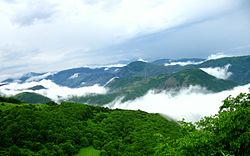
Arasbārān in the former Qaradagh, is a UNESCO registered biosphere reserve (since 1976) and an Iranian Dept. of Environment designated "Protected Area" in East Azarbaijan Province, Iran, with a varying altitude from 256m in the vicinity of the Aras River to 2896m and covers an area of 78560 hectares. The biosphere is also home to some 23,500 nomads. Arasbaran is confined to Aras River in the north, Meshgin Shahr County and Moghan in the east, Sarab County in the south, and Tabriz and Marand counties in the west.
Lakes
- Urmia Lake is a salt lake near Iran's border with Turkey. The lake is between the provinces of East Azerbaijan and West Azerbaijan, west of the southern portion of the similarly shaped Caspian Sea. It is the largest lake in the Middle East,
- Shorabil Lake is located in a hilly area south of Ardabil. Ardabil University is located near the lake.
- Gori Lake is a small fresh to brackish lake in the uplands of East Azarbaijan Province. Together with the adjacent reed marshes it is an important breeding area for waterfowl. A 1.2 km² site was designated as a Ramsar Convention wetland protection site on 23 June 1975.
- Neor Lake is located in a hilly area south of the Province of Ardabil, on the Ardabil–Khalkhal road.
- The smallest island of Lake Urmia, Osman fist. The smallest island of Lake Urmia, Osman fist.
-
 Shorabil Lake at night.
Shorabil Lake at night.
-
Marmishu Lake in Urmia County
-
Neor Lake on the Ardabil — Khalkhal road
Plain
The Mugan plain is a plain located beteeen Iran and the southern part of the Republic of Azerbaijan. The highest density of irrigation canals is in the section of the Mugan plain which lies in the Republic of Azerbaijan. It is located on the bank of the Aras river extending to Iran.
The Urmia Plain is in the West Azerbaijan Province, situated on western side of Lake Urmia and the eastern side of Turkish border.
Politics
In Azerbaijan
| Province | Governor-general | Representative of the Supreme Leader | Province | Governor-general | Representative of the Supreme Leader |
|---|---|---|---|---|---|
| East Azerbaijan | Easmaeil Jabbarzadeh | Mohsen Mojtahed Shabestari | West Azerbaijan | Ghorbanali Saadat | Mehdi Ghoreyshi |
| Ardabil Province | Majid Khodabakhsh | Hassan Ameli | Zanjan Province | Jamshid Ansari | Ali Khatami |
Assembly of Experts
Of the 86 members of Assembly of Experts, 11 are representative of the Azerbaijan region. Ali Meshkini from Meshgin Shahr in the Ardabil Province was Chairmen of the Assembly of Experts since 1983 to 2007.
- 5 representative of East Azerbaijan.
- 3 representative of West Azerbaijan.
- 2 representative of Ardabil Province.
- 1 representative of Zanjan Province.
Islamic Consultative Assembly
Of the 290 members of Islamic Consultative Assembly, 44 are representative of Azerbaijan region.
- Electorate According to County
- Electoral district of East Azerbaijan
- 19
- Tabriz, Osku, Azarshahr
- 6
- Meyaneh
- 2
- Kaleybar, Khoda Afarin
- 1
- Marand, Jolfa
- 1
- Sarab
- 1
- Bostanabad
- 1
- Maragheh, Ajabshir
- 1
- Hashtrud, Charuymaq
- 1
- Bonab
- 1
- Varzagan
- 1
- Ahar, Heris
- 1
- Shabestar
- 1
- Malekan
- 1
- Electoral district of West Azerbaijan
- 12
- Urmia
- 3 (1 person Kurd)
- Miandoab, Shahin Dezh, Takab
- 2
- Khoy, Chaypareh
- 1
- Mahabad
- 1 (Kurd)
- Bukan
- 1 (Kurd)
- Maku, Poldasht, Showt, Chaldoran
- 1
- Nagadeh, Oshnavieh
- 1 (Kurd)
- Salmas
- 1
- Piranshahr, Sardasht
- 1 (Kurd)
- Electoral district of Ardabil Province
- 7
- Ardabil, Nir, Namin, Sareyn
- 3
- Khalkhal, Kowsar
- 1
- Bileh Savar, Parsabad
- 1
- Electoral district of Zanjan Province
- 5
- Zanjan, Tarom
- 2
- Ijrud, Mahneshan
- 1
Cabinet of Iran
- Mohammadreza Nematzadeh: Minister of Industries and Business
- Hamid Chitchian: Minister of Energy
- Shahindokht Molaverdi: vice president of Iran the section Women and Family Affairs.
Consulate
| Country | Name | City | Province | Country | Name | City | Province |
|---|---|---|---|---|---|---|---|
| Turkish Consulate in Tabriz | Tabriz | East Azerbaijan | Turkish Consulate in Urmia | Urmia | West Azerbaijan | ||
| Republic of Azerbaijan Consulate in Tabriz | Tabriz | East Azerbaijan |
Military
In Azerbaijan are based several Iranian Army and Sepah divisions and brigades, including:
| Type | Name | City | Province | Type | Name | City | Province |
|---|---|---|---|---|---|---|---|
| Operational Headquarter of Army in North-West | Northwestern Operational Headquarter of Ground Forces of Islamic Republic of Iran Army | Urmia | West Azerbaijan | Division (military) of Army | 64th Infantry Division of Urmia | Urmia | West Azerbaijan |
| Division (military) of Army | 21st Infantry Division of Azerbaijan | Tabriz | East Azerbaijan | Logistic Headquarter of Army | Maraqeh District 4 Headquarter | Maragheh | East Azerbaijan |
| Brigade of Army | 40th Infantry Separate Brigade of Sarab | Sarab & Ardabil | East Azerbaijan & Ardabil Province | Brigade of Army | 41st Infantry Separate Brigade of Qushchi | Urmia | West Azerbaijan |
| Separate Brigade of Army | 36th Armored Separate Brigade of Mianeh | Tabriz | East Azerbaijan | Army Training Centre of Army | 03 Ajabshir Recruit Training Centre | Ajab Shir | East Azerbaijan |
| Military airbase of Islamic Republic of Iran Army Aviation | Havanirooz Tabriz Base | Tabriz | East Azerbaijan | Military airbase of Air force | Tactical Air Base 2, or Paygah Dovvom-e Shekari | Tabriz | East Azerbaijan |
| Agency of Navy | Navy Office of Tabriz | Tabriz | East Azerbaijan |
| Tape | Name | City | Province | Tape | Name | City | Province |
|---|---|---|---|---|---|---|---|
| Provincial Corps | Ardabil Hazrat Abbas Provincial Corps | Ardabil | Ardabil province | Provincial Corps | West Azerbaijan Shohada Provincial Corps | Urmia | West Azerbaijan |
| Provincial Corps | East Azerbaijan Ashura Provincial Corps | Tabriz | East Azerbaijan | Provincial Corps | Zanjan Ansar al-Mahdi Provincial Corps | Zanjan | Zanjan province |
Economy

Companies and industries
Industries include machine tools, vehicle factories, oil refinery, petrochemical complex, food processing, cement, textiles, electric equipment, and sugar milling. Oil and gas pipelines run through the region. Wool, carpets, and metal ware are also produced. In some factories and major companies in Azerbaijan include:
- Iran Tractor Manufacturing Company: is a tractor manufacturing company with headquarters in Tabriz. Iran Tractor Manufacturing Company is currently exporting 13 different products to ten countries. and has qualified for ISO 9001, and has also received rewards regarding quality and exporting.
- Goldstone Tires: operating under the brand Goldstone Tires is an Iranian tire manufacturer for automobiles, commercial trucks, light trucks, SUVs, race cars, airplanes, and heavy earth-mover machinery in Ardabil. Artawheel Tire is currently the largest non-government owned tire manufacturer in Iran by marketshare. The company currently has agreements with Iran Khodro to develop tires for the Peugeot 206 Models
- Mashin Sazi Tabriz: which is also called by its abbreviation MST, is a Machine tool manufacturing factory in Tabriz. The major products of the factory are machinery tools such as turning machines, milling machines, drilling machines, grinding machines.
- Rakhsh Khodro Diesel: is an Iranian truck manufacturer established in 2005 and located in Tabriz. This company is strategic partner of Kamaz of Russia, JAC and Jinbei of China and Maz-Man of Belarus and produces Kamaz trucks, JAC light trucks and its own designed minibus. Its headquarters is in Tabriz.
- Iran Khodro: is the leading Iranian vehicle manufacturer, with headquarters in Tehran. The company's original name was Iran National. In addition to Tehran, largest car factory in Iran have 5 automobile factories throughout the Iran. and "Iran Khodro - Tabriz" have produces capacity 61,000 Bardo Pick-up in year. also this Irankhodro site produces 100 Samand in day.
- Tabriz International Exhibition Center: which is a complex with vast exhibition infrastructures, is located in the eastern part of Tabriz. It holds tens of exhibitions based on a yearly schedule. There are 46 exhibitions scheduled for the current Iranian year. The most famous fair is TEXPO, which is a general trade fair.
- Aras Free Zone: is situated in East Azarbaijan province, in the north-west of Iran, adjacent to Nakhchivan Autonomous Republic, Armenia and the Republic of Azerbaijan. Existence of the greenhouse town in the AFTZ, which has been built upon cooperation of Agricultural Jihad Ministry, has paved the ground for presence of investors in the arena of planting hydroponic products. The 500-megawatt combined cycle power plant project which is currently underway in AFTZ as a joint investment venture with foreign parties.
- Maku Free Zone: is situated in West Azarbaijan province, in the north-west of Iran, adjacent to Turkey.
- and other major petrochemical companies, oil refineries and industries are including Machine works Company of Tabriz, Iranian Diesel Engine Manufacturing (IDEM), Tabriz Oil Refinery, Tabriz Petrochemical, Copper Mine Songon, etc.
Rugs and carpets
The Ardabil Carpet and Tabriz rug the best kind of Iranian carpet. Now 40 percent of Iranian carpet exports are carried through East Azarbaijan. Azerbaijani carpets and rugs are important:
- Tabriz rug is a type in the general category of Iranian carpets from the city of Tabriz.
- Heriz rug are Persian rugs from the area of Heris, East Azerbaijan, northeast of Tabriz. Such rugs are produced in the village of the same name in the slopes of Mount Sabalan.
- Ardabil rug and Ardabil carpet originate from Ardabil. Ardabil has a long and illustrious history of Azerbaijani carpet weaving. The reign of the Safavid Dynasty in the 16th and 17th centuries represented the peak of Azerbaijani carpet making in the region.
- Karadagh rug or Karaja rug is handmade in or near the village of Qarājeh (Karaja), in the Qareh Dāgh (Karadagh) region just south of the Azerbaijan border, northeast of Tabrīz. The best-known pattern shows three geometric medallions that are somewhat similar to those in Caucasian carpets. The central one has a latch-hooked contour and differs in colour from the others, which are eight-pointed stars.
-
 The Ardabil Carpet
The Ardabil Carpet
-
Tabriz rug
-
 Heriz rug
Heriz rug
- Zanjan rug Zanjan rug
- Shahsevan rug Shahsevan rug
-
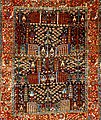 Karadagh rug
Karadagh rug
Agriculture
Grains, fruits, cotton, rice, nuts, and tobacco are the staple crops of the region.
Demographics
People
See also: Iranian Azerbaijanis, List of Iranian Azerbaijanis, Demographics of Iran, and Ethnic minorities in Iran
Iranian Azerbaijanis, also known as Azerbaijani Turks, are a Turkic-speaking people of mixed Caucasian, Iranian and Turkic origin, who number 16 — 17 — 21.6 — 24 percent and also 15 — 15.5 — 16 million of Iran's population, and comprise by far the second-largest ethnic group in the nation. In the Azerbaijan region, the population consists mainly of Azerbaijanis. Azeris are the largest group in Iranian Azerbaijan, while Kurds are the second largest group and a majority in many cities of West Azerbaijan Province. Iranian Azerbaijan is one of the richest and most densely populated regions of Iran. Many of these various linguistic, religious, and tribal minority groups, and Azeris themselves have settled widely outside the region. The majority Azeris are followers of Shi'a Islam. The Iranian Azerbaijanis mainly reside in the northwest provinces, including the Iranian Azerbaijan provinces (East Azerbaijan, West Azerbaijan, Ardabil, and Zanjan), as well as regions of the North to Hamadan County and Shara District in the East Hamadan Province, some regions Qazvin Province and also Azerbaijani minorities living in Markazi, Kordestan, Gilan and Kermanshah.
Smaller groups, such as Armenians, Assyrians, Talyshs, Jews, Circassians, (and other Peoples of the Caucasus), and Persians also inhabit the region.
Religion
The majority of Azerbaijanis in Azerbaijan are followers of Twelver Shia Islam. Azerbaijanis commemorate Shia holy days (ten first days of the holy month of Muharram) minority Sunni Azerbaijani Turks (Shafi and Hanafi) who live in the Ardabil Province (Hashatjin and villages of Bileh Savar County) and West Azarbaijan province (near the cities of Urmia, Khoy and Salmas) and have population about 200,000 people in this area.
Immigration
Azerbaijani people mostly live in northwest parts of Iran. But large Azerbaijani populations can be found in Khorasan mostly in Mashhad city. and central Iran due to internal migration to Tehran, Karaj, Qum wherever they have settled they have become prominent not only among urban and industrial working classes but also in commercial, administrative, political, religious, and intellectual circles. Azerbaijanis make up 25%– 33% of Tehran and Tehran Province's population. They are the largest ethnic groups after Persians in Tehran and the Tehran Province. also Governor of Tehran, is Hossein Hashemi from Sarab in East Azerbaijan. and Ali Khamenei Supreme Leader of Iran was born Mashhad, origin Azeri from Khameneh. Varliq and Azari journals is printed by the Azerbaijani people in Tehran.
Population

According to the population census of 2012, the four provinces of East Azerbaijan (2012 pop. 3,724,620), West Azarbaijan (2012 pop. 3,080,576), Zanjan (2012 pop. 1,015,734), and Ardabil (2012 pop. 1,248,488) have a combined population of 9 million people.
Administrative divisions
Azerbaijan's major cities are Tabriz (the capital of East Azerbaijan), Urmia (the capital of West Azerbaijan), Zanjan (the capital of Zanjan Province), Ardabil (the capital of Ardabil Province) and Major cities non-capital of Province's Azerbaijan are Khoy and Maragheh.
| Rank | Name | Image | County | Province | Population (County) | Rank | Name | Image | Country | Province | Population (County) |
|---|---|---|---|---|---|---|---|---|---|---|---|
| 1 | Tabriz | 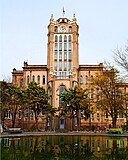 |
Tabriz County | East Azerbaijan | 1,695,094 | 2 | Urmia | 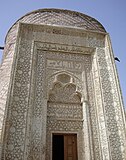 |
Urmia County | West Azerbaijan | 963,738 |
| 3 | Ardabil | 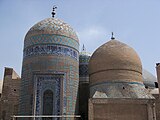 |
Ardabil County | Ardabil Province | 564,365 | 4 | Zanjan | 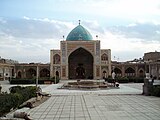 |
Zanjan County | Zanjan Province | 486,495 |
| 5 | Khoy |  |
Khoy County | West Azerbaijan | 354,309 | 6 | Miandoab | Miandoab County | West Azerbaijan | 260,628 | |
| 7 | Maragheh |  |
Maragheh County | East Azerbaijan | 247,681 | 8 | Marand |  |
Marand County | East Azerbaijan | 239,209 |
New administrative divisions

Ministry of Interior of Hassan Rouhani's government stated: 31 Province in Iran conversion to Region, and 3rd Region in North-West Iran named Region 3 that are included East Azerbaijan Province, West Azerbaijan Province, Ardabil Province, Zanjan Province, Gilan Province and Kurdistan Province.
Culture
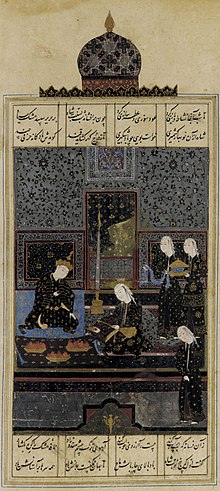
Azerbaijanis, a Turkic people, have been culturally influenced by the Iranian peoples and have influenced them in turn, as they have been part of historic Iran for centuries, if not the cornerstone of it. At the same time, they have influenced and been influenced by their non-Iranian neighbors, especially the Turkish people and the Russians. Azerbaijanis in both Iran and the Republic of Azerbaijan are mostly Shiite Muslims, unlike the other Turkic peoples, who are mostly Sunni Muslims. Azerbaijanis in Iran and in the republic of Azerbaijan celebrate Novruz, the Iranian new year celebrated at the arrival of spring. Azerbaijan has a distinct music that is tightly connected to Persian music, Turkish traditional music, Kurdish music, and the music of the Caucasian peoples. Despite severe restrictions and oppression, Azerbaijani dances and Azerbaijani folk music continue to survive in Iranian Azerbaijan. Although the Azerbaijani language is not an official language of Iran it is widely used, mostly orally, among the Iranian Azerbaijanis.
Literature
Many poets that came from Azerbaijan wrote poetry in both Persian and Azerbaijani. Renowned poets in Azerbaijani language are Nasimi, Shah Ismail I (who was known with the pen-name Khatai), Fuzuli, Nasimi and Jahan Shah were probably born outside what is now Iranian Azerbaijan. Azerbaijani was the dominant language of the ruling dynasties of the Turkic rulers of the area such as the Ak Koyunlu, Kara Koyunlu and later it was used in the Safavid for court, until Isfahan became capital and religious dignitaries, military. In the 16th century, Azerbaijani literature further flourished with the development of Ashik (Template:Lang-az) poetic genre of bards. During the same period, under the pen-name of Khatāī (Template:Lang-ar for sinner) Shah Ismail I wrote about 1400 verses in Azerbaijani, which were later published as his Divan. A unique literary style known as qoshma (Template:Lang-az for improvisation) was introduced in this period, and developed by Shah Ismail and later by his son and successor, Shah Tahmasp and Tahmasp I. In the span of the 17th century, 18th and 19th century, Fizuli's unique genres as well Ashik poetry were taken up by prominent poets and writers such as Qovsi Tabrizi, Shah Abbas Sani, Khasta Qasim, Mirza Fatali Akhundov, Seyid Abulgasim Nabati, Ali Mojuz and others.
An influential piece of post-World War II Azerbaijani poetry, Heydar Babaya Salam (Greetings to Heydar Baba) was written by Azeri poet Mohammad Hossein Shahriar who had already established himself as a notable. This poem, published in Tabriz in 1954 and written in colloquial Azerbaijani, became popular among Iranians and the people of Azerbaijan. In Heydar Babaya Salam, Shahriar expressed his identity as an Iranian Azerbaijani attached to his homeland, language, and culture. Heydar Baba is a hill near Khoshknab, the native village of the poet.
Azerbaijan is mentioned favorably on many occasions in Persian literature by Iran's greatest authors and poets. Examples:
گزیده هر چه در ایران بزرگان
زآذربایگان و ری و گرگان
All the nobles and greats of Iran,
Choose from Azerbaijan, Ray, and Gorgan.
—Vis o Ramin
از آنجا بتدبیر آزادگان
بیامد سوی آذرآبادگان
From there the wise and the free,
set off to Azerbaijan
—Nizami
به یک ماه در آذرآبادگان
ببودند شاهان و آزادگان
For a month's time, The Kings and The Free,
Would choose in Azerbaijan to be
—Ferdowsi
UNESCO World Heritage Sites
Nine historical sites in Azerbaijan have been designated as World Heritage Sites by UNESCO:
- Bazaar of Tabriz: is one of the oldest bazaars in the Middle East and the largest covered bazaar in the world. The bazaar was declared to be a World Heritage Site in July 2010.
- Sheikh Safi al-Din Khānegāh and Shrine Ensemble: is the tomb of Sheikh Safi-ad-din Ardabili located in Ardabil, Iran. In 2010, it was registered on the UNESCO World Heritage List.
- Takht-e Soleymān: literally the Throne of Solomon, in earlier ancient periods known as Shiz or Adur Gushnasp, literally the Fire of the Warrior Kings) is an archaeological site in West Azarbaijan. It lies midway between Urmia and Hamadan, very near the present-day town of Takab,
- Dome of Soltaniyeh: located near Zanjan, 240 kilometres (150 mi) to the north-west of Tehran, used to be the capital of Mongol Ilkhanid rulers of Persia in the 14th century. Its name translates as The Imperial. In 2005, UNESCO listed Soltaniyeh as one of the World Heritage Sites. The road from Zanjan to Soltaniyeh extends until it reaches to the Katale khor cave.
- Five churchs in Azerbaijan: St. Thaddeus Monastery, Saint Stepanos Monastery, Church of the Holy Mother of God, Darashamb, Chapel of Dzordzor and Church of Chupan are World Heritage Sites.
-
 Bazaar of Tabriz
Bazaar of Tabriz
-
 Sheikh Safi al-Din Khānegāh and Shrine Ensemble
Sheikh Safi al-Din Khānegāh and Shrine Ensemble
-
 Takht-e Soleymān
Takht-e Soleymān
-
 Soltanieh Dome in Soltaniyeh
Soltanieh Dome in Soltaniyeh
-
 Qara Klisa
Qara Klisa
Colleges and universities
There are many universities in Azerbaijan, included units and centers: public university and private university Islamic Azad University, Payame Noor University, Nonprofit educational institutions, University of Applied Science and Technology.
Some of the most prestigious public universities in the area are:
-
Ardabil University of Medical Sciences
- Mohaghegh Ardabili University main entrance Mohaghegh Ardabili University main entrance
-
Physics department interior of IASBS in Zanjan
-
 Zanjan University
Zanjan University
-
 Joseph Cochran in Westminister Hospital Urmia (Now Urmia University of Medical Sciences)
Joseph Cochran in Westminister Hospital Urmia (Now Urmia University of Medical Sciences)
-
 Shahid Chamran Hall (central library) — of Urmia University
Shahid Chamran Hall (central library) — of Urmia University
-
 Behnam House is part of the School of Architecture of Tabriz Islamic Arts University
Behnam House is part of the School of Architecture of Tabriz Islamic Arts University
-
 Tabriz University Tower Clock
Tabriz University Tower Clock
-
 Maragheh observatory
Maragheh observatory
Architecture
Azeri style is a style (sabk) of architecture when categorizing Iranian architecture development in Azerbaijan history. Landmarks of this style of architecture span from the late 13th century (Ilkhanate) to the appearance of the Safavid Dynasty in the 16th century CE.
Ashik

Ashik is a mystic bard, balladeer, or troubadour who accompanied his song be it a hikaye or a shorter original composition with a long necked lute. The modern Azerbaijani ashiq is a professional musician who usually serves an apprenticeship, masters playing saz, and builds up a varied but individual repertoire of Turkic folk songs. and The Coffeehouse of Ashiks is a coffeehouse in cities of Azerbaijan where ashiks perform Turkish hikaye. In cities, towns, and villages of Iranian Azerbaijan ashiks entertain audiences in coffeehouses.
Transportation
Air
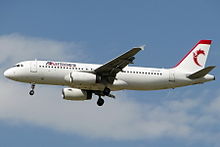
Ata Airlines is an airline based in Tabriz, Iran. Operates scheduled domestic services and international services in the Middle East, as well as charter services including Europe. Its main base is Tabriz International Airport. in this airplane company is in Azerbaijan with Eram Air.
Commercial and Passenger airports in Azerbaijan:
Bridge
- Urmia Lake Bridge is a bridge in region. It crosses Lake Urmia and connects East Azerbaijan and West Azerbaijan.
- Meshginshahr suspension bridge is Middle East's largest suspension bridge in height of 80 meters.
- Tabriz Cable Bridge is a biggest cable-stayed bridge in Iran
Railway
Tabriz Railway Station is a was founded in Tabriz, in 1917; the current building was built during second Pahlavi era by Iranian architect Heydar Ghiaï-Chamlou. The first railroad arriving to Tabriz had been built by Russian. The railway started from Jolfa, a city on the border of Iran and the modern Republic of Azerbaijan.
Active lines this railway included: Tabriz — Tehran, Tabriz — Nakhchivan Autonomous Republic and Tabriz — Turkey.
Metro
Tabriz Metro being built in the Tabriz City since 2001. this metro have 5 line (4 line is main, 1 line is vicinity) and the total length is 75 kilometers. one's line Tabriz metro El-Golu in southeast connect to Laleh district in the southwest.
Roads
| type | Number Road | Distance (Km) | City of Origin | City of Destination | Location | Image |
|---|---|---|---|---|---|---|
| Freeways | Freeway 2 (Iran) | 600 | Tehran | Tabriz (Az) | 
|

|
| Highways and Roads | Road 11 (Iran) | 325 | Jolfa (Az) | Baneh | 
|
|
| Highways and Roads | Road 12 (Iran) | 572 | Bazargan (Az) | Bileh Savar (Az) | 
|
|
| Highways and Roads | Road 14 (Iran) | 460 | Razi, Ardabil (Az) | Salmas (Az) | 
|
|
| Highways and Roads | Road 16 (Iran) | 428 | Astara | Serow (Az) | 
|
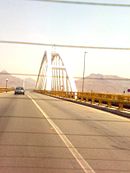
|
| Highways and Roads | Road 21 (Iran) | 978 | Ilam | Jolfa (Az) | 
|
|
| Highways and Roads | Road 22 (Iran) | 428 | Sarakhs | Khalkhal (Az) | 
|

|
| Highways and Roads | Road 23 (Iran) | 390 | Miandoab (Az) | Hamadan | 
|
|
| Highways and Roads | Road 24 (Iran) | 142 | Hashtrud (Az) | Bonab (Az) | 
|
|
| Highways and Roads | Road 26 (Iran) | 151 | Miandoab (Az) | Piranshahr (Az) | 
|
|
| Highways and Roads | Road 27 (Iran) | 245 | Khomarlu (Az) | Tabriz (Az) | 
|
|
| Highways and Roads | Road 31 (Iran) | 539 | Parsabad (Az) | Manjil | 
|
|
| Highways and Roads | Road 32 (Iran) | 880 | Tehran | Bazargan (Az) | 
|
|
| Highways and Roads | Road 33 (Iran) | 155 | Ardabil (Az) | Bileh Savar (Az) | 
|
|
| Highways and Roads | Road 35 (Iran) | 155 | Zanjan (Az) | Khorramabad | 
|
Media

TV and radio
- Sahand TV from Tabriz
- Eshragh TV from Zanjan
- Sabalan TV from Ardebil
- West Azerbaijan TV from Urmia
Newspapers
|
|
Sport

Top sport clubs
Representatives of Azerbaijani in the top leagues.
- Football
- Futsal
- Volleyball
- Basketball
- Cycling Team
Important hosts
- Azerbaijan International Cycling Tour: is an annual professional road bicycle racing stage race held in Iran since 1986, named after Azerbaijan, Iran. The race is categorized by International Cycling Union (UCI) as a 2.2 category race as part of the Asia Tours.
- 2010 Asian Men's Cup Volleyball Championship Ghadir Arena in Urmia.
- 2012 WAFF Futsal Championship Ghadir Arena in Urmia.
- 2012 Asian Junior Men's Volleyball Championship Ghadir Arena in Urmia.
- 16th Wrestle International Children's Day Shahid Poursharifi Arena in Tabriz.
- 2014 Asian Men's Junior Handball Championship Shahid Poursharifi Arena in Tabriz.
- 1976: Part of 1976 AFC Asian Cup's final tournament held in Bagh Shomal Stadium, Tabriz.
Sports facilities
Large and important stadiums:
- Yadegar-e Emam Stadium
- Ali Daei Stadium
- Takhti Stadium
- Gostaresh Foulad Stadium
- Tabriz Cycling Track
- Shahid Pour Sharifi Arena
- Ghadir Arena
- Rezazadeh Stadium
- Marzdaran Stadium
- Tractor Stadium
See also
Column-generating template families
The templates listed here are not interchangeable. For example, using {{col-float}} with {{col-end}} instead of {{col-float-end}} would leave a <div>...</div> open, potentially harming any subsequent formatting.
| Type | Family | Handles wiki table code? |
Responsive/ mobile suited |
Start template | Column divider | End template |
|---|---|---|---|---|---|---|
| Float | "col-float" | Yes | Yes | {{col-float}} | {{col-float-break}} | {{col-float-end}} |
| "columns-start" | Yes | Yes | {{columns-start}} | {{column}} | {{columns-end}} | |
| Columns | "div col" | Yes | Yes | {{div col}} | – | {{div col end}} |
| "columns-list" | No | Yes | {{columns-list}} (wraps div col) | – | – | |
| Flexbox | "flex columns" | No | Yes | {{flex columns}} | – | – |
| Table | "col" | Yes | No | {{col-begin}}, {{col-begin-fixed}} or {{col-begin-small}} |
{{col-break}} or {{col-2}} .. {{col-5}} |
{{col-end}} |
Can template handle the basic wiki markup {| | || |- |} used to create tables? If not, special templates that produce these elements (such as {{(!}}, {{!}}, {{!!}}, {{!-}}, {{!)}})—or HTML tags (<table>...</table>, <tr>...</tr>, etc.)—need to be used instead.
Notes
- ^a Reporting and estimation World Factbook and Library of Congress
- ^b Reporting and estimation Looklex Encyclopaedia
- ^c Reporting and estimation New America Foundation
- ^d Reporting and estimation Minority Rights Group International
- ^e Reporting and estimation Britannica Encyclopaedia
- ^f Reporting and estimation Ethnologue
- ^g Reporting and estimation Encyclopædia Iranica, The number of Turkic speakers in Iran today is estimated about 16 million, The majority are ethnic Azeris
- ^h Just in Sonqor County
- ^i Reza Rahmani, Mohammad Esmaeil Saeidi, Masoud Pezeshkian, Mohammad Hosein Farhanghi, Mir-Hadi Gharaseyyed Romiani, Alireza Mondi Sefidan
- ^j Javad Jahanghirzadeh, Abed Fattahi and Nader Ghazipour
- ^k Mansour Haghighatpour, Kamaladin Pirmoazzen and Mostafa Afzalifard
- ^m Mohammad Esmaeili (politician) and Mohsen Alimardani
- ^n Bahlul Hoseini and Mohammad Ali Madadi
- ^o Rohollah Beighi Eilanlu and Mehdi Isazadeh
References
- James Minahan. "Miniature Empires", Published by Greenwood Publishing Group, 1998.
- Brown, Cameron S. 2002 (Dec.). "Observations from Azerbaijan." Middle East Review of International Affairs: v. 6, no. 4, (LINK)
- Michael P. Croissant, "The Armenia-Azerbaijan Conflict: Causes and Implications", Praeger/Greenwood, 1998. excerpt from pg 61: "During the Soviet-era historical revisionism and myth-building intended to denounce imperialism, the notion of a "northern" and "southern" Azerbaijan was created and propagated throughout USSR. It was charged that the "two Azerbaijanis" once united were separated artificially by conspiracy between imperial Russia and Iran".
- Ethnic Conflict and International Security, Edited by Michael E. Brown, Princeton University Press, 1993
- Bert G. Fragner, ‘Soviet Nationalism’: An Ideological Legacy to the Independent Republics of Central Asia ’ in" in Van Schendel, Willem(Editor) . Identity Politics in Central Asia and the Muslim World: Nationalism, Ethnicity and Labour in the Twentieth Century. London , GBR: I. B. Tauris & Company, Limited, 2001. Excerpt from pg 24: "Under Soviet auspices and in accordance with Soviet nationalism, historical Azerbaijan proper was reinterpreted as 'Southern Azerbaijan', with demands for liberation and, eventually, for 're'-unification with Northern (Soviet) Azerbaijan a breathtaking manipulation. No need to point to concrete Soviet political activities in this direction, as in 1945–46 etc. The really interesting point is that in the independent former Soviet republics this typically Soviet ideological pattern has long outlasted the Soviet Union."
- ^ Swietochowski, Tadeusz (1995). Russia and Azerbaijan: A Borderland in Transition. Columbia University Press. pp. 69, 133. ISBN 978-0-231-07068-3.
- ^ Swietochowski, Tadeusz. Eastern Europe, Russia and Central Asia 2003 Taylor and Francis, 2003. ISBN 1857431375 p 104
- ^ Timothy C. Dowling Russia at War: From the Mongol Conquest to Afghanistan, Chechnya, and Beyond pp 728-729 ABC-CLIO, 2 dec. 2014 ISBN 1598849484
- ^ Siavash Lornejad, Ali Doostzadeh. ON THE MODERN POLITICIZATION OF THE PERSIAN POET NEZAMI GANJAVI CCIS, 2012 ISBN 978-9993069744 p 10
- Atroapates. Encyclopædia Iranica
- Minahan, James (1998). Miniature Empires: A Historical Dictionary of the Newly Independent States. Greenwood Publishing Group. p. 20. ISBN 978-0-313-30610-5.
- Chamoux, François (2003). Hellenistic Civilization. John Wiley and Sons. p. 26. ISBN 978-0-631-22241-5.
- Bosworth A.B., Baynham E.J. (2002). Alexander the Great in Fact and fiction. Oxford University Press. p. 92. ISBN 978-0-19-925275-6.
- Encyclopædia Iranica, "ATROPATES" M. L. Chaumont.
- FRAWARDIN YASHT ("Hymn to the Guardian Angels") Translated by James Darmesteter (From Sacred Books of the East, American Edition, 1898)
- Minorsky, V.; Minorsky, V. "Azerbaijan" Encyclopaedia of Islam. Edited by: P. Bearman, Th. Bianquis, C.E. Bosworth, E. van Donzel and W.P. Heinrichs. Brill
- R. C. Zaehner, The Teachings of the Magi, London, 1956, p. 101
- G. Gnoli, Zoroaster's time and homeland, Naples, 1980
- MANNEA by R. Zadok in Encyclopaedia Iranica
- "Mede". Encyclopædia Britannica. 2007. Encyclopædia Britannica Online. 12 February 2007 <http://www.britannica.com/eb/article-9051719>
- Hovannisian, Richard G. (1999). Armenian Van/Vaspurakan. Costa Mesa, California: Mazda Publishers. ISBN 1-56859-130-6.
- Hewsen, Robert H. (August 17, 2011). "AVARAYR". Encyclopædia Iranica.
So spirited was the Armenian defense, however, that the Persians suffered enormous losses as well. Their victory was pyrrhic and the king, faced with troubles elsewhere, was forced, at least for the time being, to allow the Armenians to worship as they chose.
- Susan Paul Pattie (1997). Faith in History: Armenians Rebuilding Community. Smithsonian Institution Press. p. 40. ISBN 1560986298.
The Armenian defeat in the Battle of Avarayr in 451 proved a pyrrhic victory for the Persians. Though the Armenians lost their commander, Vartan Mamikonian, and most of their soldiers, Persian losses were proportionately heavy, and Armenia was allowed to remain Christian.
- The Caspian: politics, energy and security, By Shirin Akiner, pg.158
- Administrative Department of the President of the Republic of Azerbaijan - Presidential Library - Religion
- Juan Eduardo Campo,Encyclopedia of Islam, p.625
- ^ Fisher et al. 1991, p. 329.
- Alekseĭ I. Miller. Imperial Rule Central European University Press, 2004 ISBN 9639241989 p 204
- L. Batalden, Sandra (1997). The newly independent states of Eurasia: handbook of former Soviet republics. Greenwood Publishing Group. p. 98. ISBN 978-0-89774-940-4.
- E. Ebel, Robert, Menon, Rajan (2000). Energy and conflict in Central Asia and the Caucasus. Rowman & Littlefield. p. 181. ISBN 978-0-7425-0063-1.
{{cite book}}: CS1 maint: multiple names: authors list (link) - Andreeva, Elena (2010). Russia and Iran in the great game: travelogues and orientalism (reprint ed.). Taylor & Francis. p. 6. ISBN 978-0-415-78153-4.
- Çiçek, Kemal, Kuran, Ercüment (2000). The Great Ottoman-Turkish Civilisation. University of Michigan. ISBN 978-975-6782-18-7.
{{cite book}}: CS1 maint: multiple names: authors list (link) - Ernest Meyer, Karl, Blair Brysac, Shareen (2006). Tournament of Shadows: The Great Game and the Race for Empire in Central Asia. Basic Books. p. 66. ISBN 978-0-465-04576-1.
{{cite book}}: CS1 maint: multiple names: authors list (link) - Younes Parsa Benab, "The Gilan Soviet Republic and Azadistan in Iranian Azerbaijan (1917–1921)", accessed April 2, 2007
- Jessup, John E. (1989). A Chronology of Conflict and Resolution, 1945–1985. New York: Greenwood Press. ISBN 0-313-24308-5.
- For more information see: Ali Morshedizad, Roshanfekrane Azari va Hoviyate Melli va Ghomi (Azari Intellectuals and Their Attitude to National and Ethnic Identity (Tehran: Nashr-e Markaz publishing co., 1380)
- Cold War International History Project Virtual Archive 2.0 Collection: 1945–46 Iranian Crisis
- Kleiss, Wolfram. "AZERBAIJAN xii. MONUMENTS". Encyclopædia Iranica. Retrieved 2013-12-27.
- ^ "Azerbaijan". Encyclopædia Britannica. 2009-03-09. (excerpt:"geographic region that comprises the extreme northwestern portion of Iran. It is bounded on the north by the Aras River, which separates it from independent Azerbaijan and Armenia; on the east by the Iranian region of Gīlān and the Caspian Sea; on the south by the Iranian regions of Zanjān and Kordestān; and on the west by Iraq and Turkey. Azerbaijan is 47,441 square miles (122,871 square km) in area.")
- ^ "Country Study Guide-Azerbaijanis". STRATEGIC INFORMATION AND DEVELOPMENTS-USA. Retrieved 13 August 2013.
- Dizadji, H. (2010). Journey from Tehran to Chicago. Trafford Publishing. p. 105. ISBN 1-4269-2918-8.
- M. N. POGREBOVA, Encyclopædia Iranica, ARCHEOLOGY. viii. NORTHERN AZERBAIJAN (REPUBLIC OF AZERBAIJAN), 16 June 2004
- "Iran: 54 Mountain Summits with Prominence of 1,500 meters or greater" Peaklist.org. Retrieved 2011-11-21.
- East Azerbaijan Mountaineering Confedration
- National Geographic Society (2005) National Geographic Atlas of the World (8th ed.) Washington, DC, ISBN 0-7922-7542-X
- http://www.unesco.org/mabdb/br/brdir/directory/biores.asp?code=IRA+01&mode=all Profile at UNESCO biosphere reserve directory
- "Britanica". Britannica.com. Retrieved 4 September 2011.
- "Shorabil Lake". tripadvisor.in. Retrieved 18 September 2013.
- "Shorabil Lake, Ardabil, South Azerbaijan". youtube.com. Retrieved 18 September 2013.
- "Saline Systems; Urmia Salt Lake, Iran". Salinesystems.org. Retrieved 4 September 2011.
- Tapper, Richard. "MOḠĀN". Encyclopædia Iranica. Retrieved 2013-12-27.
- TTO Provinces
- "The chairman of the Assembly of Experts died" (in Persian). Radio Zamaneh. 2007-08-30. Retrieved 2007-08-08.
- "جدول مدارک تحصیلی و سوابق اجرایی اعضای 14 کمیسیون مجلس نهم". Fars News Agency. Retrieved 22 October 2013.
- News Hamshahri Online
- "15 of 18 Proposed Iranian Cabinet Ministers Devoted by Parliament". Mojnews. 16 August 2013. Retrieved 29 August 2013.
- "شهیندخت مولاوردی، معاون حسن روحانی در امور زنان شد". Persian Deutsche Welle. 13 August 2013. Retrieved 8 October 2013.
- "Ms Molaverdi appointed as vice president for women, family Affairs". President of Iran Website. 13 August 2013. Retrieved 8 October 2013.
- "تبریز، میهمان رئیس جمهور ترکیه". ISNA. Retrieved 2013-10-20.
- "مهمت بولوت سرکنسول جدید ترکیه در ارومیه ، با استاندار دیدار کرد". Asar-e Omid News Agency. Retrieved 2013-10-20.
- "Ə.F.Əlizadənin İran İslam Respublikasının Təbriz şəhərində Azərbaycan Respublikasının baş konsulu təyin edilməsi haqqında Azərbaycan Respublikası Prezidentinin Sərəncamı". Presidential Azerbaijan Website. Retrieved 2013-10-20.
- ^ Official website
- http://www.goldstoneir.com/English/index.php
- http://www.iranexportsmagazine.com/Archive/mag%2066/industry66.html
- "Internet Archive Wayback Machine". Web.archive.org. 2008-06-17. Archived from the original on 2008-06-17. Retrieved 2011-05-29.
{{cite web}}: Cite uses generic title (help) - "۲۰ هزار دستگاه وانت بار در ايران خودرو تبريز توليد شد". Islamic Republic News Agency. Retrieved 2013-10-19.
- "Bardo". Iran Khodro Website. Retrieved 2013-10-19.
- "آغاز تولید سمند در ایران خودرو تبریز/ تولید روزانه حدود 150 دستگاه آریسان و 100 دستگاه سمند". Fars News Agency. Retrieved 22 July 2015.
- ^ http://www.iran-daily.com/1389/4/13/MainPaper/3720/Page/4/Index.htm#
- "احداث موزه فرش و ايجاد پايانه صادراتي فرش در تبريز". Fars News Agency. Retrieved 2013-10-19.
- Along with Kashan, Kerman, Herat, and every major city of Iran...
- Jacoby, Heinrich (1952). How to know Oriental carpets and rugs. Allen & Unwin. p. 15.
Persian carpets: Tabriz, Ramadan, ...
- Jacobsen, Charles W. (2007). Facts about Oriental Rugs. READ BOOKS. p. 2. ISBN 1-4067-0467-9.
"Different weaves...Persian rugs..Bakhtiari..Kashan..Lorestan..Shiraz..Tabriz..
- "Karaja rug". Britannica Encyclopaedia. Retrieved 2013-10-17.
- Minorsky, V.; Minorsky, V. "(Azerbaijan). Encyclopaedia of Islam. Edited by: P. Bearman, Th. Bianquis, C.E. Bosworth, E. van Donzel and W.P. Heinrichs. Brill
- CIA, CIA. "CIA World Factbook". Retrieved 2012-05-27.
- Library of Congress, Library of Congress – Federal Research Division. "Ethnic Groups and Languages of Iran" (PDF). Retrieved 2009-12-02. 16% estimated in 2012
- "Iran / Peoples". Looklex Encyclopaedia. Retrieved 16 October 2013.
- "Results a new nationwide public opinion survey of Iran" (PDF). New America Foundation. June 12, 2009. Retrieved 13 August 2013.
- "Azeris". Minority Rights Group International. 2009. Retrieved 16 October 2013.
- "Azerbaijani". Encyclopædia Britannica. Retrieved 17 October 2013.
- "Azerbaijani, South # A language of Iran". Ethnologue. 2013. Retrieved 17 October 2013.
- "IRAN v. PEOPLES OF IRAN (1) A General Survey". Encyclopædia Iranica. March 29, 2012. Retrieved 17 October 2013.
- Brenda Shaffer. The Limits of Culture: Islam and Foreign Policy MIT Press, 2006 ISBN 0262195291 p 229
- Keith Stanley McLachlan, "The Boundaries of Modern Iran ", Published by UCL Press, 1994. pg 55
- Encyclopaedia Iranica, page 243 = accessed January 9, 2007]
- Parviz Aḏkāʾi and EIr. "HAMADĀN i. GEOGRAPHY". Encyclopædia Iranica. Retrieved 2013-10-21.
- ^ "زبانهاي رايج و نوع گويش در شهرستان". Governor of Hamadan. Retrieved 21 October 2013.
- ^ "Iran-Azerbaijanis". Library of Congress Country Studies. December 1987. Retrieved 13 August 2013.
- "معرفی استان مرکزی". Office of Culture and Islamic Guidance. Retrieved 21 October 2013.
- "Kordestān". Encyclopædia Britannica. Retrieved 21 October 2013.
- Bazin, Marcel. "GĪLĀN i. GEOGRAPHY AND ETHNOGRAPHY". Encyclopædia Iranica. Retrieved 16 October 2013.
- Parviz Aḏkāʾi and EIr. "GILĀN xiv. Ethnic Groups". Encyclopædia Iranica. Retrieved 16 October 2013.
- Michael Knüppel, E. "TURKIC LANGUAGES OF PERSIA". Encyclopædia Iranica. Retrieved 2013-09-19.
- Robertson, Lawrence R. (2002). Russia & Eurasia Facts & Figures Annual. Academic International Press. p. 210. ISBN 0-87569-199-4.
- "Bileh Savar". Encyclopædia Islamica. Retrieved 2014-08-21.
- "برگزاری جشن "وحدت" در شهر اهل تسنن هشتجین". International Quran News Agency. Retrieved 2014-08-21.
- Hun, Abubakr. "ترکهای سنّی آذربایجان غربی قربانیان تبعیض مضاعف". urmu.freeoda. Retrieved 2014-08-21.
- ^ Tapper, R. "AZERBAIJAN vi. Population and its Occupations and Culture". Encyclopædia Iranica. Retrieved 16 October 2013.
- "Mourning Azerbaijanis residing in Mashhad". Mehr News Agency. August 18, 2011. Retrieved 23 August 2013.
- "Tehran". Looklex Encyclopaedia. Retrieved 2013-07-04.
- "Tehran, Political situation". Municipality of Tehran. Retrieved 2013-08-16.
- "سیدحسین هاشمی استانداری تهران را تحویل گرفت". Hamshahri Online. Retrieved 2013-10-21.
- "سید حسین هاشمی استاندار تهران شد". Mehr News Agency. Retrieved 2013-10-21.
- "Azeris unhappy at being butt of national jokes". IRIN. UN Office for the Coordination of Humanitarian Affairs. 25 May 2006. Retrieved 2009-06-19.
- Jun 8, 2006 (2006-06-08). "Asia Times Online :: Middle East - Foreign plots and cockroaches in Iran". Atimes.com. Archived from the original on 2011-08-25. Retrieved 2009-06-19.
{{cite web}}: CS1 maint: numeric names: authors list (link) - Sep 28, 2004. "Asia Times - Asia's most trusted news source for the Middle East". Atimes.com. Archived from the original on 2011-08-25. Retrieved 2009-06-19.
{{cite web}}: CS1 maint: numeric names: authors list (link) - ^ "The population of Iranian cities". Statistical Center of Iran. 14 February 2012. Retrieved 13 August 2013.
- "تبریز مرکز استانهای آذربایجان شرقی، آذربایجان غربی، اردبیل، زنجان، گیلان و کردستان می گردد". TRT persian. July 2014. Retrieved 1 August 2014.
- "منطقهبندی کشور، بیمها و امیدها". Jamejam Online. June 2014. Retrieved 1 August 2014.
- "استانهای کشور به ۵ منطقه تقسیم شدند". Hamshahri Online. July 2014. Retrieved 1 August 2014.
- "استانهای کشور به ۵ منطقه تقسیم شدند". Entekhab Online. July 2014. Retrieved 1 August 2014.
- "ایران، فدرال می شود؟ تقسیم کشور به 5 منطقه مستقل". Khabar-Online. July 2014. Retrieved 1 August 2014.
- "استانهای کشور به ۵ منطقه تقسیم شدند". Jamejam Online. July 2014. Retrieved 1 August 2014.
- "استانهای کشور به 5 منطقه تقسیم شدند". yjc. July 2014. Retrieved 1 August 2014.
- ^ "AZERBAIJAN x. Azeri Turkish Literature". Encyclopaedia Iranica. May 24, 2012. Retrieved 20 October 2013.
- V. Minorsky. "Jihān-Shāh Qara-Qoyunlu and His Poetry (Turkmenica, 9)", Bulletin of the School of Oriental and African Studies, University of London, Vol. 16, No. 2 (1954), p. 277
- Cyril Glassé (ed.), The New Encyclopedia of Islam, Lanham, Maryland: Rowman & Littlefield Publishers, revised ed., 2003, ISBN 0-7591-0190-6, p. 392: "Shah Abbas moved his capital from Qazvin to Isfahan. His reigned marked the peak of Safavid dynasty's achievement in art, diplomacy, and commerce. It was probably around this time that the court, which originally spoke a Turkic language, began to use Persian"
- Zabiollah Safa (1986), "Persian Literature in the Safavid Period", The Cambridge History of Iran, vol. 6: The Timurid and Safavid Periods. Cambridge: Cambridge University Press, ISBN 0-521-20094-6, pp. 948–65. P. 950: "In day-to-day affairs, the language chiefly used at the Safavid court and by the great military and political officers, as well as the religious dignitaries, was Turkish, not Persian; and the last class of persons wrote their religious works mainly in Arabic. Those who wrote in Persian were either lacking in proper tuition in this tongue, or wrote outside Iran and hence at a distance from centers where Persian was the accepted vernacular, endued with that vitality and susceptibility to skill in its use which a language can have only in places where it truly belongs."
- Price, Massoume (2005). Iran's Diverse Peoples: A Reference Sourcebook. ABC-CLIO. p. 66. ISBN 978-1-57607-993-5.
The Shah was a native Turkic speaker and wrote poetry in the Azerbaijani language.
{{cite book}}: Cite has empty unknown parameter:|coauthors=(help) - Encyclopædia Iranica. ٍIsmail Safavi
- Minorsky, Vladimir (1942). "The Poetry of Shah Ismail". Bulletin of the School of Oriental and African Studies, University of London. 10 (4): 1053. doi:10.1017/S0041977X00090182.
{{cite journal}}: Cite has empty unknown parameters:|month=and|coauthors=(help) - "World Heritage Committee inscribes seven cultural sites on World Heritage List". UNESCO World Heritage Centre. 31 July 2010.
- "Tabriz Historic Bazaar Complex". UNESCO World Heritage Centre. Retrieved 1 July 2013.
- "Sheikh Safi al-din Khānegāh and Shrine Ensemble in Ardabil - UNESCO World Heritage Centre". Whc.unesco.org. 2010-07-29. Retrieved 2010-08-02.
- Source: Unescopress. "World Heritage Committee inscribes seven cultural sites on World Heritage List | United Nations Educational, Scientific and Cultural Organization". Unesco.org. Retrieved 2010-08-02.
- Huff, Dietrich (2002-07-20). "Taḵt-e Solaymān". Encyclopædia Iranica. Retrieved 2013-06-11.
- Fallāḥʹfar, Saʻīd (سعید فلاحفر). The Dictionary of Iranian Traditional Architectural Terms (Farhang-i vāzhahʹhā-yi miʻmārī-i sunnatī-i Īrān فرهنگ واژههای معماری سنتی ایران). Kamyab Publications (انتشارات کامیاب). Kāvushʹpardāz. 2000, 2010. Tehran. ISBN 978-964-2665-60-0 US Library of Congress LCCN Permalink: http://lccn.loc.gov/2010342544 pp.16
- Colin P. Mitchell (Editor), New Perspectives on Safavid Iran: Empire and Society, 2011, Routledge, 90-92
- Basgoz, I. (1970). Turkish Hikaye-Telling Tradition in Azerbaijan, Iran. Journal of American Folklore, 83(330), 394.
- Albright, C. F. (1976). "The Azerbaijani cashiq and his performance of a dästän. Iranian Studies". Iranian Studies. 9 (4): 220–247. doi:10.1080/00210867608701517.
- "متروی تبریز اوایل خردادماه به راه میافتد". INN. Retrieved 2013-10-19.
- ^ "لیست نشریات استان اردبيل". List of periodicals in the Iranian Provinces. Retrieved 17 October 2013.
- "ارومیه فعال در حوزه مطبوعات/ انتشار اولین نشریه شهرستانی در ارومیه". Mehr News Agency. 6 October 2013. Retrieved 17 October 2013.
- ^ "لیست نشریات استان زنجان". List of periodicals in the Iranian Provinces. Retrieved 17 October 2013.
- ^ "لیست نشریات آذربایجان شرقی". Mayor of Tabriz Website. Retrieved 17 October 2013.
Sources
- Fisher, William Bayne; Avery, P.; Hambly, G. R. G; Melville, C. (1991). The Cambridge History of Iran. Vol. 7. Cambridge: Cambridge University Press. ISBN 0521200954.
{{cite book}}: Invalid|ref=harv(help)
External links
| Azerbaijani people by country or region | |
|---|---|
| Traditional areas | |
| Former Soviet Union | |
| Europe | |
| Americas | |
| See also | |








